Attached files
| file | filename |
|---|---|
| 8-K - PDL BIOPHARMA INC 8-K 01-09-2012 - PDL BIOPHARMA, INC. | form8k.htm |
Exhibit 99.1
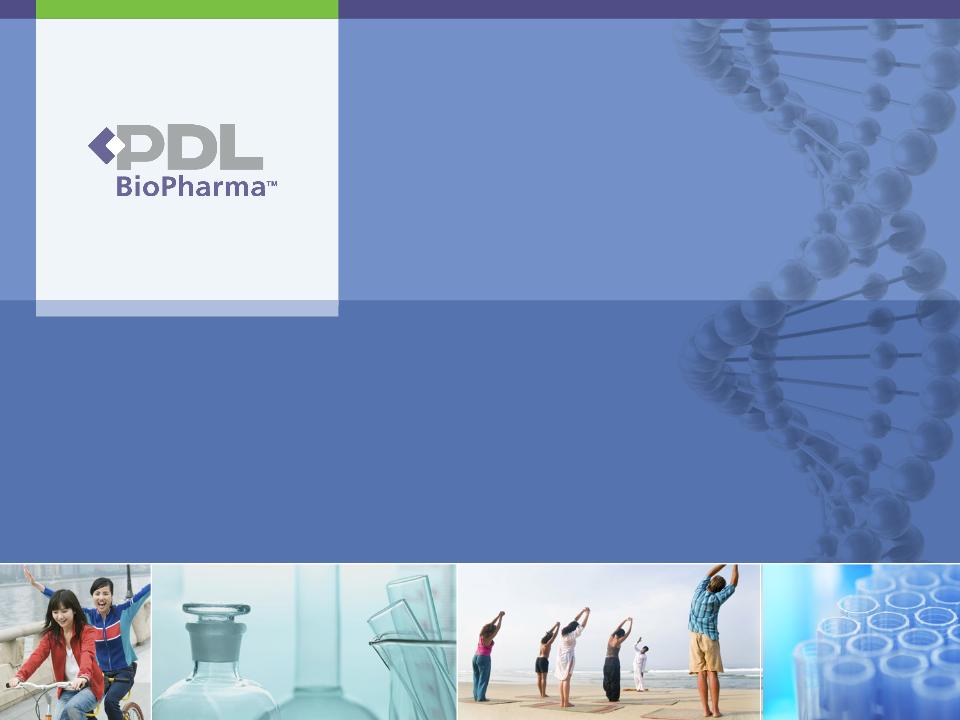
30th Annual J.P. Morgan Healthcare Conference
January 9-12, 2012
1

Forward Looking Statements
This presentation contains forward-looking statements, including PDL’s expectations with respect to its future
royalty revenues, expenses, net income, and cash provided by operating activities.
royalty revenues, expenses, net income, and cash provided by operating activities.
Each of these forward-looking statements involves risks and uncertainties. Actual results may differ materially
from those, express or implied, in these forward-looking statements. Factors that may cause differences between
current expectations and actual results include, but are not limited to, the following:
from those, express or implied, in these forward-looking statements. Factors that may cause differences between
current expectations and actual results include, but are not limited to, the following:
▪ The expected rate of growth in royalty-bearing product sales by PDL’s existing licensees;
• The relative mix of royalty-bearing Genentech products manufactured and sold outside the U.S. versus manufactured or
sold in the U.S.;
sold in the U.S.;
• The ability of PDL’s licensees to receive regulatory approvals to market and launch new royalty-bearing products and
whether such products, if launched, will be commercially successful;
whether such products, if launched, will be commercially successful;
• Changes in any of the other assumptions on which PDL’s projected royalty revenues are based;
• Changes in foreign currency rates;
• Positive or negative results in PDL’s attempt to acquire royalty-related assets;
• The outcome of pending litigation or disputes, including PDL’s current dispute with Genentech related to ex-U.S. sales of
Genentech licensed products; and
Genentech licensed products; and
• The failure of licensees to comply with existing license agreements, including any failure to pay royalties due.
Other factors that may cause PDL’s actual results to differ materially from those expressed or implied in the
forward-looking statements in this presentation are discussed in PDL’s filings with the SEC, including the "Risk
Factors" sections of its annual and quarterly reports filed with the SEC. Copies of PDL’s filings with the SEC may
be obtained at the "Investors" section of PDL’s website at www.pdl.com. PDL expressly disclaims any obligation
or undertaking to release publicly any updates or revisions to any forward-looking statements contained herein
to reflect any change in PDL’s expectations with regard thereto or any change in events, conditions or
circumstances on which any such statements are based for any reason, except as required by law, even as new
information becomes available or other events occur in the future. All forward-looking statements in this
presentation are qualified in their entirety by this cautionary statement.
forward-looking statements in this presentation are discussed in PDL’s filings with the SEC, including the "Risk
Factors" sections of its annual and quarterly reports filed with the SEC. Copies of PDL’s filings with the SEC may
be obtained at the "Investors" section of PDL’s website at www.pdl.com. PDL expressly disclaims any obligation
or undertaking to release publicly any updates or revisions to any forward-looking statements contained herein
to reflect any change in PDL’s expectations with regard thereto or any change in events, conditions or
circumstances on which any such statements are based for any reason, except as required by law, even as new
information becomes available or other events occur in the future. All forward-looking statements in this
presentation are qualified in their entirety by this cautionary statement.
2

|
Company
|
PDL BioPharma, Inc.
|
|
Ticker
|
PDLI (NASDAQ)
|
|
Location
|
Incline Village, Nevada
|
|
Employees
|
Less than 10
|
|
2010 Revenues
|
$345 million
|
|
2011 Anticipated Revenue
|
$361 million
|
|
2011 Regular Dividends
|
$0.15 /share paid on March 15, June 15,
September 15 & December 15 |
|
Q3-2011 Cash Position1
|
$225 million
|
|
Shares O/S2
|
~ 140 million
|
|
Average Daily Volume
|
~ 2 million shares
|
Key Information
1. As of September 30, 2011; 2. Not fully diluted
3

Overview of PDL BioPharma
4

Company Overview
• PDL pioneered the humanization of monoclonal antibodies
which enabled the discovery of a new generation of targeted
treatments for cancer and immunologic diseases
which enabled the discovery of a new generation of targeted
treatments for cancer and immunologic diseases
• PDL’s primary assets are its antibody humanization patents
and royalty assets which consist of its Queen et al. patents
and license agreements
and royalty assets which consist of its Queen et al. patents
and license agreements
• Licensees consist of large biotechnology and
pharmaceutical companies including Roche/Genentech/
Novartis, Elan/BiogenIdec, Pfizer/Wyeth/J&J and Chugai
pharmaceutical companies including Roche/Genentech/
Novartis, Elan/BiogenIdec, Pfizer/Wyeth/J&J and Chugai
5
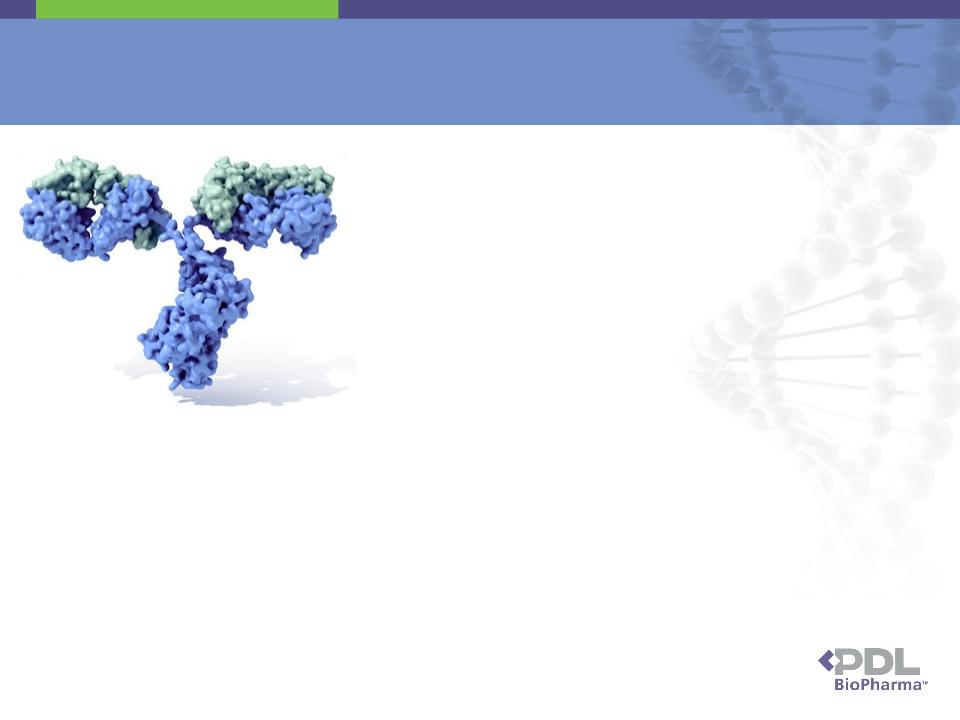
Antibody Humanization Technology
• Antibodies are naturally produced by humans to fight
foreign substances, such as bacteria and viruses
foreign substances, such as bacteria and viruses
• In the 1980’s, scientists began creating antibodies in
non-human immune systems, such as those of mice,
that could target specific sites on cells to fight various
human diseases
non-human immune systems, such as those of mice,
that could target specific sites on cells to fight various
human diseases
• However, mouse derived antibodies are recognized by
the human body as foreign substances and may be
rejected by the human immune system
the human body as foreign substances and may be
rejected by the human immune system
• PDL’s technology allows for the “humanization” of mouse derived antibodies by moving
the important binding regions from the mouse antibody onto a human framework
the important binding regions from the mouse antibody onto a human framework
• PDL’s humanization technology is important because the humanized antibodies retain the
binding and activity levels from the original mouse antibody
binding and activity levels from the original mouse antibody
• PDL’s technology has been incorporated into antibodies to treat cancer, eye diseases,
arthritis, multiple sclerosis and other health conditions with aggregate annual sales of
over $17 billion
arthritis, multiple sclerosis and other health conditions with aggregate annual sales of
over $17 billion
6

Mission Statement
• Queen et al. Patents
▪ Manage patent portfolio
▪ Manage license agreements
• Purchase new royalty generating assets
▪ Assets that improve shareholder return
▪ Commercial stage assets
▪ Prefer biologics with strong patent protection
• Optimize return for shareholders
7

Corporate Governance
Management
• John McLaughlin
President & CEO
President & CEO
• Christopher Stone
VP, General Counsel &
Secretary
VP, General Counsel &
Secretary
• Caroline Krumel
VP of Finance
VP of Finance
• Danny Hart
Associate General Counsel
Associate General Counsel
Board of Directors
• Fred Frank
Lead Director
Lead Director
• Jody Lindell
• John McLaughlin
• Paul Sandman
• Harold Selick
8

Licensed Products and Royalty Revenue
9

Approved Licensed Products: Overview
1. As reported to PDL by its licensee 2. As reported by Roche; assume 1.155 CHF/USD
10

How Long Will PDL Receive Royalties from
Queen et al. Patents?
Queen et al. Patents?
• PDL’s revenues consist of royalties generated on sales of licensed products
▪ Sold in a patented jurisdiction before the expiration of the Queen et al. patents in mid-2013 through end of
2014
2014
or
▪ Made prior to the expiration of the Queen et al. patents in a patented jurisdiction and sold anytime
thereafter
thereafter
Example of Antibody Formulation, Fill and Finish Schedule
½ month
1 month
½ month
2-3 months
Thaw, Formulation
& Vial Filling
& Vial Filling
Quality
Release
Release
Packaging
& Quality
& Quality
Inventory
Example of Antibody Bulk Manufacturing Schedule
Cell
Culture
Quality Release
Testing
Testing
Bulk Frozen Storage
1 mo
3 mos
5 mos
10 mos
15 mos
20 mos
27 mos
3 mos
2-18 months
1mo
1mo
Purification to Concentrated Bulk/Frozen
11

|
Genentech Product Made or Sold in U.S.
|
|
|
Net Sales up to $1.5 Billion
|
3.0%
|
|
Net Sales Between $1.5 Billion and $2.5 Billion
|
2.5%
|
|
Net Sales Between $2.5 Billion and $4.0 Billion
|
2.0%
|
|
Net Sales Over $4.0 Billion
|
1.0%
|
|
Genentech Product Made and Sold Ex-U.S.
|
|
|
Net Sales
|
3.0%
|
Queen et al Patents - Royalty Rates
• Tysabri and Actemra
• Flat, low single-digit royalty
• Genentech Products (Avastin, Herceptin, Lucentis1 and Xolair)
• Tiered royalties on product made or sold in US
• Flat, 3% royalty on product made and sold outside US
• Blended global royalty rate on Genentech Products in 2010 was 1.9%
• Blended royalty rate on Genentech Products in 2010 made or sold in US was
1.5%
1.5%
1. As part of a settlement with Novartis, which commercializes Lucentis outside US, PDL agreed to pay to Novartis
certain amounts based on net sales of Lucentis made by Novartis during calendar year 2011 and beyond. The
amounts to be paid are less than we receive in royalties on such sales and we do not currently expect such amount
to materially impact our total annual revenues in 2011.
certain amounts based on net sales of Lucentis made by Novartis during calendar year 2011 and beyond. The
amounts to be paid are less than we receive in royalties on such sales and we do not currently expect such amount
to materially impact our total annual revenues in 2011.
12

Potential Shift to Ex-US Manufacturing Sites =
Higher Royalties
Higher Royalties
• Roche is moving some manufacturing ex-US which may result in higher royalties to PDL due
to the flat 3% royalty for Genentech Products made and sold ex-US
to the flat 3% royalty for Genentech Products made and sold ex-US
▪ Current production at Penzburg (Herceptin) and Basel (Avastin) plants
▪ Two new plants in Singapore (CHO = antibody and e. coli = antibody fragment)
- E. coli (Lucentis) and CHO (Avastin) plants are approved for commercial supply to the US
- E. coli and CHO plants are expected to be approved for commercial supply to the EU
- Currently, all Lucentis is made in the US
Percent of Net Worldwide Sales1
1. As reported to PDL by its licensee
13

Royalty Revenue & Licensed Products
Royalties by Product
($ in millions)
14

Royalty Products - Approved
15
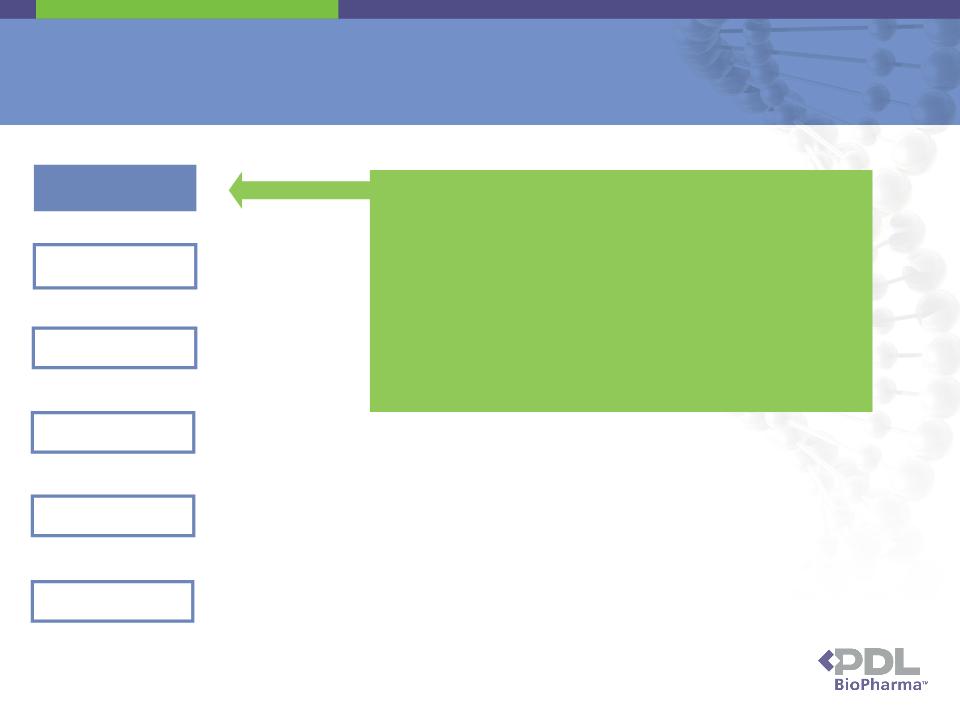
Royalty Products - Avastin
Avastin
Herceptin
Lucentis
Xolair
Tysabri
Actemra
ü On November 18, 2011, FDA revoked its approval for
treatment of HER2-negative breast cancer effective
immediately.
treatment of HER2-negative breast cancer effective
immediately.
§ This decision does not affect any of the Avastin’s other
approvals.
approvals.
§ Genentech announced that it will start Phase 3 trial in
2012 of Avastin plus paclitaxel in previously untreated
metastatic breast cancer.
2012 of Avastin plus paclitaxel in previously untreated
metastatic breast cancer.
ü EMEA narrowed, but did not withdraw Avastin’s approval for
first line treatment of HER2- breast cancer in combination
with paclitaxel or with Xeloda.
first line treatment of HER2- breast cancer in combination
with paclitaxel or with Xeloda.
16

Royalty Products - Herceptin
Avastin
Herceptin
Lucentis
Xolair
Tysabri
Actemra
ü On October 18, 2011, Roche announced Phase 3 results that
showed that subcutaneous (SQ) formulation of Herceptin has
comparable safety and efficacy to intravenous (IV) formulation.
showed that subcutaneous (SQ) formulation of Herceptin has
comparable safety and efficacy to intravenous (IV) formulation.
ü SQ formulation is ready-to-use and requires about 5 minutes to
administer compared to 30 minutes administration time for IV
formulation.
administer compared to 30 minutes administration time for IV
formulation.
17

Royalty Products - Lucentis
Avastin
Herceptin
Lucentis
Xolair
Tysabri
Actemra
ü On January 7, 2011, Novartis announced that Lucentis has been
approved in the EU for the treatment of visual impairment due to
diabetic macular edema (DME).
approved in the EU for the treatment of visual impairment due to
diabetic macular edema (DME).
ü In October 2011, Genentech announced that it had filed an
application for approval with the FDA for the treatment of visual
impairment due to DME.
application for approval with the FDA for the treatment of visual
impairment due to DME.
ü On June 6, 2011, Novartis announced that Lucentis has been
approved in the EU for the treatment of visual impairment due to
macular edema secondary to retinal vein occlusion.
approved in the EU for the treatment of visual impairment due to
macular edema secondary to retinal vein occlusion.
§ DME is a leading cause of blindness in the working-age
population in most developed countries.
population in most developed countries.
ü On June 28, 2011, Genentech reported positive results from two
pivotal Phase 3 clinical studies in patients with diabetic macular
edema.
pivotal Phase 3 clinical studies in patients with diabetic macular
edema.
§ Both studies showed that patients treated with Lucentis
experienced significant, rapid and sustained improvement in
vision compared to those who received sham injections.
experienced significant, rapid and sustained improvement in
vision compared to those who received sham injections.
§ Additional analyses showed that patients who received
Lucentis were significantly more likely to achieve 20/40 vision
and experience less progression of underlying diabetic
retinopathy disease.
Lucentis were significantly more likely to achieve 20/40 vision
and experience less progression of underlying diabetic
retinopathy disease.
18
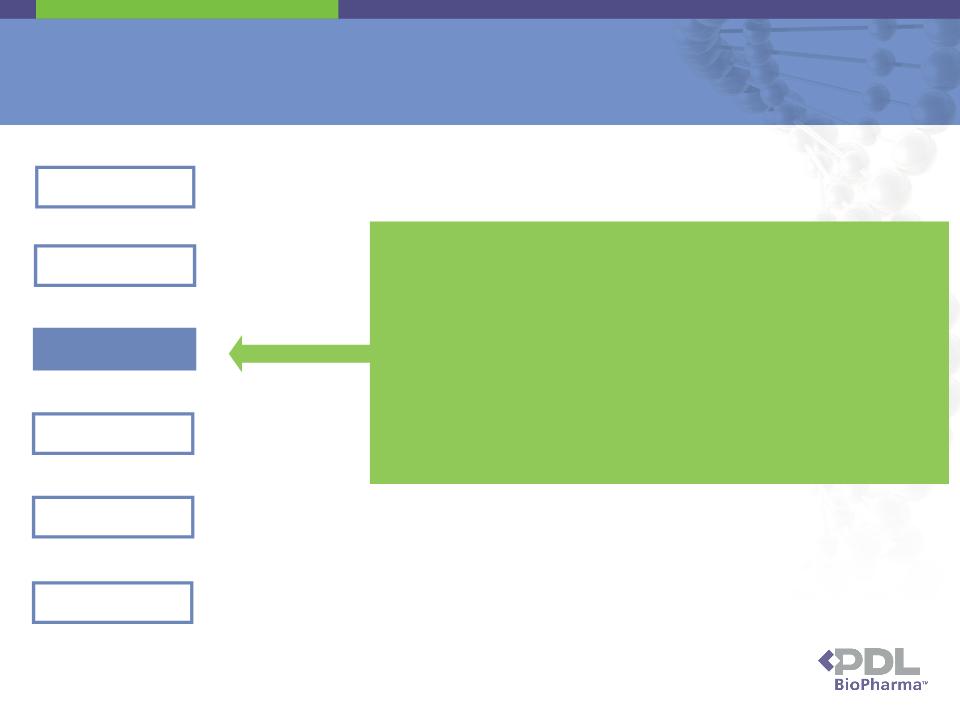
Royalty Products - Lucentis
19
Avastin
Herceptin
Lucentis
Xolair
Tysabri
Actemra
ü On November 18, 2011, FDA approved Regeneron and Bayer’s Eylea
for the treatment of age-related macular degeneration (AMD).
for the treatment of age-related macular degeneration (AMD).
§ FDA approved a dosing schedule of monthly injections for the
first three months and bi-monthly injections thereafter.
first three months and bi-monthly injections thereafter.
§ Many physicians currently give AMD patients monthly injections
of Lucentis for the first few months and then treat on an “as
needed to maintain vision” basis.
of Lucentis for the first few months and then treat on an “as
needed to maintain vision” basis.
§ Eylea is priced at $100 less per injection than Lucentis
(Lucentis = $1,950 per injection)
(Lucentis = $1,950 per injection)
ü On January 3, 2012, Regeneron and Genentech announced a
settlement of their patent litigation regarding Eylea under which
Regeneron will pay royalties to Genentech on Eylea sales.
settlement of their patent litigation regarding Eylea under which
Regeneron will pay royalties to Genentech on Eylea sales.

Royalty Products - Tysabri
Avastin
Herceptin
Lucentis
Xolair
Tysabri
Actemra
ü In the label for Tysabri, EMEA has included, and FDA is
considering including, JC virus (JCV) status as a risk factor for the
rare but sometimes fatal brain infection known as PML.
considering including, JC virus (JCV) status as a risk factor for the
rare but sometimes fatal brain infection known as PML.
ü Because patients have increased risk of developing PML after 24
months of Tysabri treatment and because physicians can use this
assay to detect presence of JC virus and take patients off Tysabri if
JC virus is detected, physicians have become more comfortable
prescribing Tysabri.
months of Tysabri treatment and because physicians can use this
assay to detect presence of JC virus and take patients off Tysabri if
JC virus is detected, physicians have become more comfortable
prescribing Tysabri.
ü As of October 4, 2011, Biogen Idec reported net patients adds of
2,100 and 170 cases of PML.
2,100 and 170 cases of PML.
§ Net patient adds is the difference between new patients
treated less those who discontinued Tysabri therapy due to
JC virus status or other reasons.
treated less those who discontinued Tysabri therapy due to
JC virus status or other reasons.
20

Potential Royalty Products
- Development Stage
- Development Stage
21

Potential Royalty Products - T-DM1
T-DM1
Breast HER2+ Cancer
ü On October 13, 2010, Roche/Genentech announced preliminary,
six month results from a Phase 3 trial in second line HER2+
breast cancer patients which showed that 48% of women treated
with T-DM1 had their tumors shrink compared with 41% of those
taking the combination of Herceptin and Taxotere.
six month results from a Phase 3 trial in second line HER2+
breast cancer patients which showed that 48% of women treated
with T-DM1 had their tumors shrink compared with 41% of those
taking the combination of Herceptin and Taxotere.
§ Among the women taking the standard therapy, 75% had
side effects of grade 3 or higher on a 5-point scale,
compared with 37% of those getting T-DM1.
side effects of grade 3 or higher on a 5-point scale,
compared with 37% of those getting T-DM1.
ü Roche highlighted this product in their November 7, 2011 update
to the financial community on their late stage development
products.
to the financial community on their late stage development
products.
ü Roche/Genentech expect to file for second line approval in 2012
and first line in 2014.
and first line in 2014.
Ocrelizumab
Multiple Sclerosis
Pertuzumab
Breast HER2+ Cancer
Afutuzumab
Chronic Lymphocytic
Leukemia
Leukemia
Solanezumab
Alzheimer’s Disease
Daclizumab
Multiple Sclerosis
Datoluzumab
Colorectal Cancer
Bapineuzumab
Alzheimer’s Disease
Farletuzumab
Ovarian Cancer
22
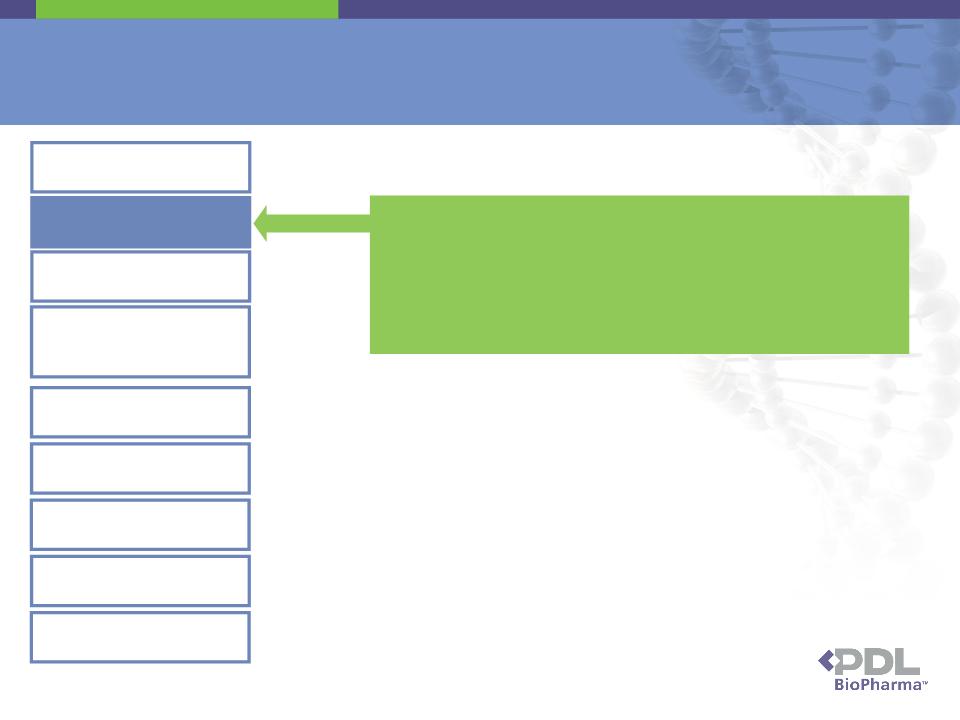
Potential Royalty Products - Ocrelizumab
T-DM1
Breast HER2+ Cancer
ü Phase 2b.
ü Genentech announced 96-week results from Phase 2 study in
patients with relapsing-remitting multiple sclerosis which showed
that the significant reduction in disease activity as measured by
the total number of active brain lesions and relapses, previously
reported for 24 weeks, was maintained through 96 weeks.
patients with relapsing-remitting multiple sclerosis which showed
that the significant reduction in disease activity as measured by
the total number of active brain lesions and relapses, previously
reported for 24 weeks, was maintained through 96 weeks.
ü Unlicensed product.
Ocrelizumab
Multiple Sclerosis
Pertuzumab
Breast HER2+ Cancer
Afutuzumab
Chronic Lymphocytic
Leukemia
Leukemia
Solanezumab
Alzheimer’s Disease
Daclizumab
Multiple Sclerosis
Datoluzumab
Colorectal Cancer
Bapineuzumab
Alzheimer’s Disease
Farletuzumab
Ovarian Cancer
23

Potential Royalty Products - Pertuzumab
24
T-DM1
Breast HER2+ Cancer
ü On December 10, 2010, Roche/Genentech reported the results
from a Phase 2 trial investigating the neoadjuvant (prior to
surgery) use of pertuzumab and Herceptin plus chemotherapy
for the treatment of early-stage, HER2+ breast cancer.
from a Phase 2 trial investigating the neoadjuvant (prior to
surgery) use of pertuzumab and Herceptin plus chemotherapy
for the treatment of early-stage, HER2+ breast cancer.
§ Treatment significantly improved the rate of complete
tumor disappearance in the breast by more than half
compared to Herceptin plus docetaxel, p=0.014.
tumor disappearance in the breast by more than half
compared to Herceptin plus docetaxel, p=0.014.
§ On July 15, 2011, Roche/Genentech reported the results
from a Phase 3 trial in pertuzumab plus Herceptin and
docetaxel met the primary endpoint of progression-free
survival (PFS) vs. Herceptin plus docetaxel alone.
from a Phase 3 trial in pertuzumab plus Herceptin and
docetaxel met the primary endpoint of progression-free
survival (PFS) vs. Herceptin plus docetaxel alone.
ü Roche highlighted this product in their November 7, 2011 update
to the financial community on their late stage development
products.
to the financial community on their late stage development
products.
ü On December 7, 2011, Genentech and Roche announced that
they had filed applications for approval in US and EU for
treatment of patients with previously untreated, HER2-positive
metastatic breast cancer.
they had filed applications for approval in US and EU for
treatment of patients with previously untreated, HER2-positive
metastatic breast cancer.
Ocrelizumab
Multiple Sclerosis
Pertuzumab
Breast HER2+ Cancer
Afutuzumab
Chronic Lymphocytic
Leukemia
Leukemia
Solanezumab
Alzheimer’s Disease
Daclizumab
Multiple Sclerosis
Datoluzumab
Colorectal Cancer
Bapineuzumab
Alzheimer’s Disease
Farletuzumab
Ovarian Cancer

Potential Royalty Products - Afutuzumab
T-DM1
Breast HER2+ Cancer
ü Phase 3.
ü Roche/Genentech expect to file for approval in 2013.
Ocrelizumab
Multiple Sclerosis
Pertuzumab
Breast HER2+ Cancer
Afutuzumab
Chronic Lymphocytic
Leukemia
Leukemia
Solanezumab
Alzheimer’s Disease
Daclizumab
Multiple Sclerosis
Datoluzumab
Colorectal Cancer
Bapineuzumab
Alzheimer’s Disease
Farletuzumab
Ovarian Cancer
25

Potential Royalty Products - Bapineuzumab
T-DM1
Breast HER2+ Cancer
ü Phase 3.
ü On July 19, 2011, researchers from Pfizer and Johnson &
Johnson reported long-term safety of 194 patients in a mid-stage
trial of the drug that stayed on treatment after the initial phase
ended.
Johnson reported long-term safety of 194 patients in a mid-stage
trial of the drug that stayed on treatment after the initial phase
ended.
§ The brain swelling condition called vasogenic edema, which
caused safety concerns early on in the trial, may decrease
over time.
caused safety concerns early on in the trial, may decrease
over time.
ü Data expected in second half of 2012.
Ocrelizumab
Multiple Sclerosis
Pertuzumab
Breast HER2+ Cancer
Afutuzumab
Chronic Lymphocytic
Leukemia
Leukemia
Solanezumab
Alzheimer’s Disease
Daclizumab
Multiple Sclerosis
Datoluzumab
Colorectal Cancer
Bapineuzumab
Alzheimer’s Disease
Farletuzumab
Ovarian Cancer
26
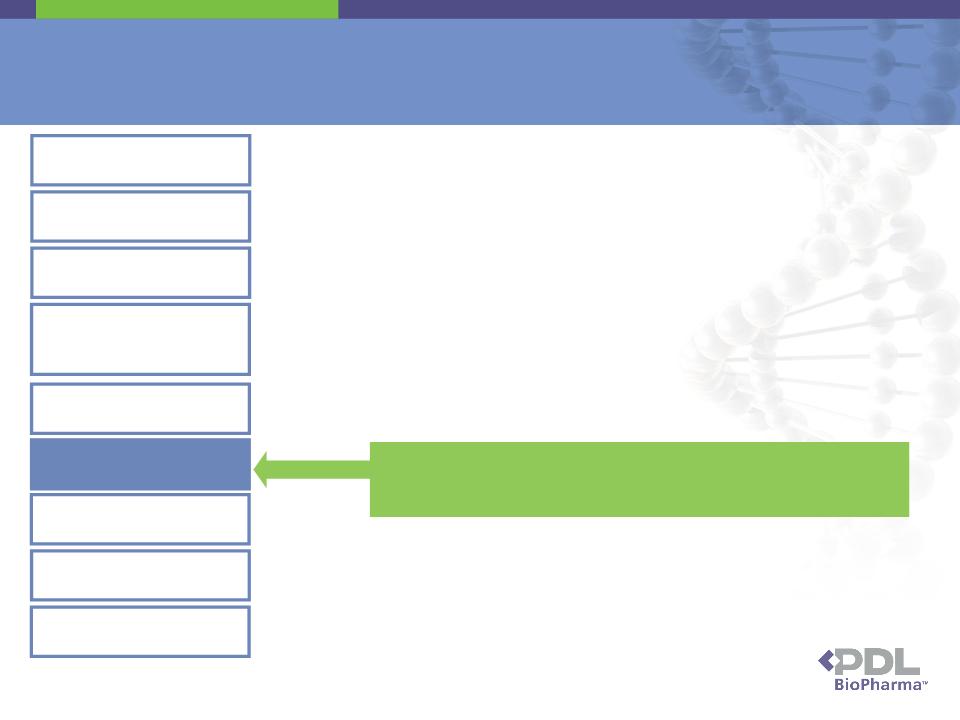
Potential Royalty Products - Solanezumab
T-DM1
Breast HER2+ Cancer
ü Phase 3.
ü Data expected in second half of 2012.
ü 12.5 year know how royalty in addition to patent royalty.
Ocrelizumab
Multiple Sclerosis
Pertuzumab
Breast HER2+ Cancer
Afutuzumab
Chronic Lymphocytic
Leukemia
Leukemia
Solanezumab
Alzheimer’s Disease
Daclizumab
Multiple Sclerosis
Datoluzumab
Colorectal Cancer
Bapineuzumab
Alzheimer’s Disease
Farletuzumab
Ovarian Cancer
27

Potential Royalty Products - Daclizumab
T-DM1
Breast HER2+ Cancer
ü Positive efficacy data reported from first of two Phase 3 trials.
Ocrelizumab
Multiple Sclerosis
Pertuzumab
Breast HER2+ Cancer
Afutuzumab
Chronic Lymphocytic
Leukemia
Leukemia
Solanezumab
Alzheimer’s Disease
Daclizumab
Multiple Sclerosis
Datoluzumab
Colorectal Cancer
Bapineuzumab
Alzheimer’s Disease
Farletuzumab
Ovarian Cancer
28
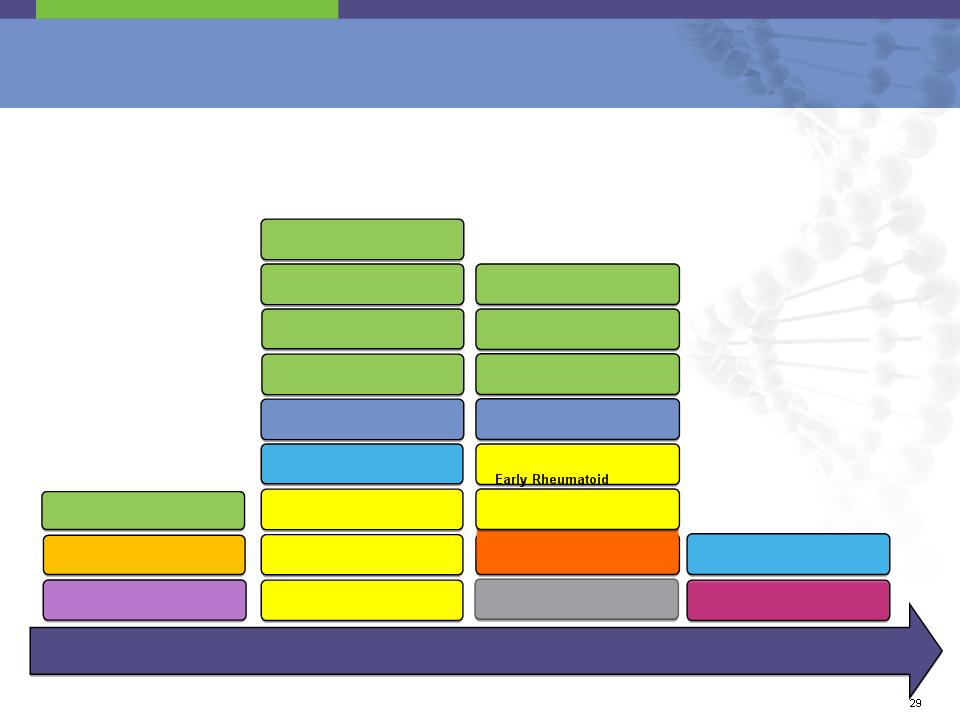
Genentech / Roche - Product Pipeline
2011
2012
2013
2014
Lucentis
Diabetic Macular Edema (US)
Pertuzumab
mBC HER2+ 1st Line
Avastin
Relapsed Ovarian Cancer (EU)
T-DM1
HER 2+ Advanced mBC
Actemra
RA DMARD H2H (EU)
Actemra
DMARD IR (US)
Herceptin
Subcutaneous Formulation
Avastin & Herceptin
HER2+ mBC 1st Line
Avastin
mCRC TML
Actemra
SC Formulation (EU)
Afutuzumab (GA101)
Chronic Lymphocytic
Leukemia
Leukemia
Actemra
Avastin
BC Adjuvant HER2+
Avastin
BC Adj Triple Negative
Herceptin
BC HER 2+ Adj 2 Year
Xolair
Chronic Urticaria
Avastin
Glioblastoma 1st Line
Actemra
SC Formulation (US)
T-DM1
HER 2+ mBC 1st Line
Ocrelizumab1
PPMS & RRMS
1.Not a licensed product
Source: Roche investor update, September 30, 2011
US & EU Filings Calendar
Avastin
MBC 2nd line (EU)
Avastin
Relapsed Ovarian Cancer (US)

Financials
30

Financial Overview
31

Debt
32

Current and Long-Term Liabilities
• $155 million 3.75% Convertible Senior Notes due May 2015
§ Notes issued May 16, 2011; current conversion rate is 135.9607 / $1,000 face amount
(~$7.36/share)
(~$7.36/share)
§ Bond hedge effectively increases conversion price to $8.65 / share
§ Notes “net share settle” and are excluded from diluted EPS
• $11 million 2.875% Convertible Senior Notes due February 2015
§ Conversion rate is 155.396 shares / $1,000 face amount (~$6.44/share)
§ On January 3, 2012, holders of approximately $169 million of these notes accepted PDL’s
offer to exchange for PDL’s new 2.875% Series 2012 Convertible Senior Notes due
February 2015 that “net share settle”
offer to exchange for PDL’s new 2.875% Series 2012 Convertible Senior Notes due
February 2015 that “net share settle”
§ Effect of exchange is to reduce potential dilution by ~26 million shares
• $169 million 2.875% Series 2012 Convertible Senior Notes due February
2015
2015
▪ Notes “net share settle” and are excluded from diluted EPS
• $300 million 10.25% secured non-recourse notes; principal balance of $115
million as of September 30, 2011
million as of September 30, 2011
§ Non-recourse notes
§ Approximately 40% of Genentech royalties dedicated to quarterly principal and interest
§ After retirement, securitized Genentech royalties will be retained by PDL
33

Legal Matters
34

Pending Dispute with Genentech and Roche
• In August 2010, Genentech sent a fax on behalf of Roche and Novartis
asserting its products do not infringe PDL’s supplementary protection
certificates (SPCs)
asserting its products do not infringe PDL’s supplementary protection
certificates (SPCs)
▪ Products include Avastin, Herceptin, Lucentis and Xolair
▪ SPCs are patent extensions in Europe that are issued on a country-by-country and product-
by-product basis
by-product basis
• PDL Response
▪ Genentech’s assertions are without merit
▪ PDL disagrees with Genentech’s assertions of non-infringement
▪ Genentech had waived its rights to challenge our patents, including SPCs in its 2003
Settlement Agreement with PDL
Settlement Agreement with PDL
• 2003 Settlement Agreement
▪ Resolved intellectual property disputes between the two companies at that time
▪ Limits Genentech’s ability to challenge infringement of PDL’s patent rights, including SPCs,
and waives Genentech’s right to challenge or assist other in challenging the validity of our
patent rights
and waives Genentech’s right to challenge or assist other in challenging the validity of our
patent rights
35

Nevada Lawsuit Against Genentech/Roche
• PDL filed a lawsuit against Genentech and Roche in Nevada state court
▪ Lawsuit states that fax constitutes a breach of 2003 Settlement Agreement because Genentech assisted
Roche in challenging PDL’s patents and SPCs
Roche in challenging PDL’s patents and SPCs
▪ Complaint seeks compensatory damages, including liquidated damages and other monetary remedies set
forth in the 2003 Settlement Agreement, punitive damages and attorney’s fees
forth in the 2003 Settlement Agreement, punitive damages and attorney’s fees
• In November 2010, Genentech and Roche filed two motions to dismiss
▪ They contend that 2003 Settlement Agreement applies only to PDL’s U.S. patents
▪ They asserted that the Nevada court lacks personal jurisdiction over Roche
• On July 11, 2011, court denied Genentech and Roche's motion to dismiss four of PDL's
five claims for relief and denied Roche's separate motion to dismiss for lack of personal
jurisdiction.
five claims for relief and denied Roche's separate motion to dismiss for lack of personal
jurisdiction.
▪ The court dismissed one of PDL's claims that Genentech committed a bad-faith breach of the covenant of
good faith and fair dealing
good faith and fair dealing
▪ Subsequent to the ruling, Roche has waived its defense that the Nevada court lacks personal jurisdiction for
the purposes of this lawsuit
the purposes of this lawsuit
• The court ruling allows PDL to continue to pursue its claims that:
▪ Genentech is obligated to pay royalties to PDL on international sales of the Genentech Products
▪ Genentech, by challenging, at the behest of Roche and Novartis, whether PDL's SPCs cover the Genentech
Products breached its contractual obligations to PDL under the 2003 settlement agreement
Products breached its contractual obligations to PDL under the 2003 settlement agreement
▪ Genentech breached the implied covenant of good faith and fair dealing with respect to the 2003 settlement
agreement
agreement
▪ Roche intentionally and knowingly interfered with PDL's contractual relationship with Genentech in
conscious disregard of PDL's rights
conscious disregard of PDL's rights
• Parties are currently in discovery
36

Optimizing Stockholder Return
37

Business Strategy
• Purchase new royalty assets and
ladder like a bond portfolio
ladder like a bond portfolio
▪ Continue to reinvest in new royalty
assets and pay dividends
assets and pay dividends
- Commercial stage products
- Sweet spot $75MM to $150MM
▪ Debt repaid by end of 2015
▪ Company continues as long as it can
generate satisfactory return
generate satisfactory return
• If unable to acquire royalty assets on
attractive terms, build cash reserves
to:
attractive terms, build cash reserves
to:
▪ Repay debt
▪ Use all excess cash to pay dividends to
enhance shareholder return
enhance shareholder return
▪ Wind-up company in 2016 timeframe
• Queen et al. patents expire in mid-2013
to December 2014; we anticipate
royalties will likely continue to ~2016
to December 2014; we anticipate
royalties will likely continue to ~2016
• PDL has two possible future pathways
38
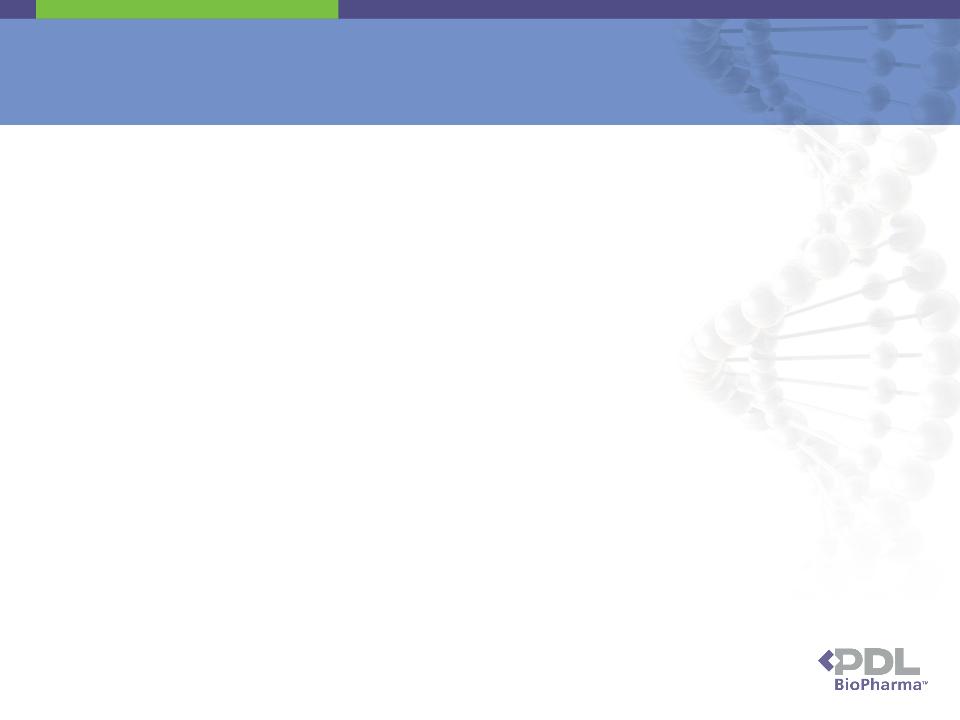
Optimizing Stockholder Return
• Continuously evaluating alternatives
▪ Dividends
▪ Capital restructure
▪ Share repurchase
▪ Company sale
▪ Purchase of commercial stage, royalty
generating assets
generating assets
39
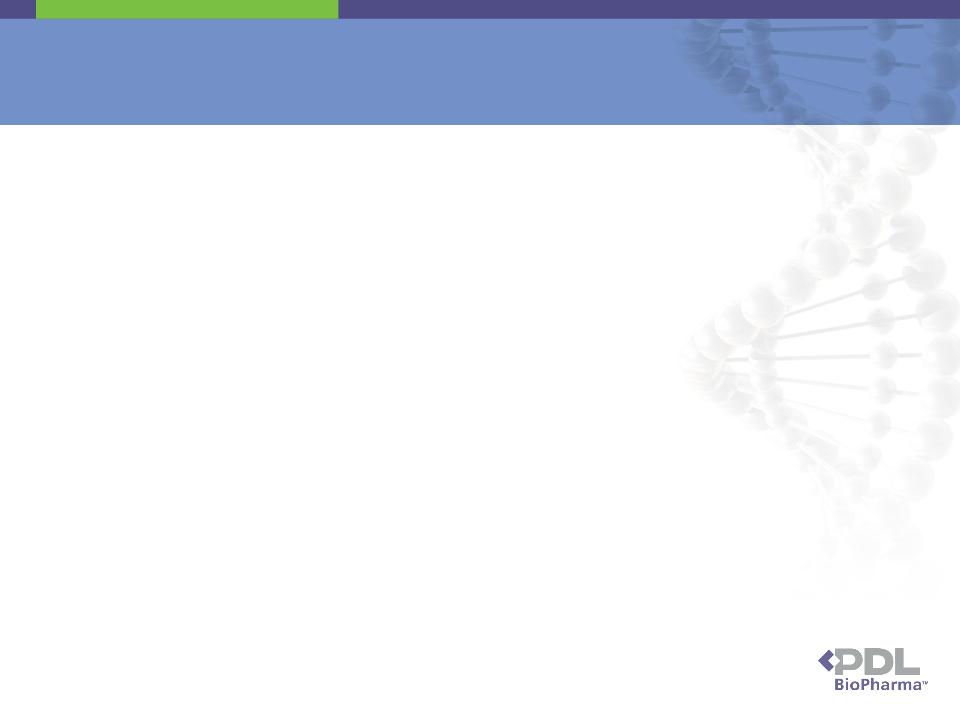
Investment Highlights
• Strong historic revenue growth from approved products
• Potential for additional indications from existing
products, new product approvals and purchase of new
royalty assets
products, new product approvals and purchase of new
royalty assets
• Potential to grow and diversify revenues with the
addition of new royalty assets
addition of new royalty assets
• Significantly reduced expenses with no R&D burn
• Liquidity - volume averages 2 million shares/day
• Return to stockholders
▪ In 2011, $0.60/share paid in quarterly regular dividends of
$0.15/share on March 15, June 15, September 15 and
December 15
$0.15/share on March 15, June 15, September 15 and
December 15
▪ 2012 Dividend Policy to be announced shortly
40
